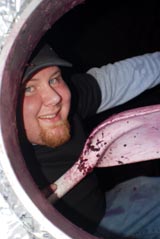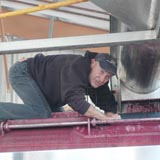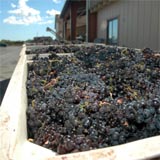|
6:08
I’m a little late, and they’ve already started picking. It’s still dark but I can tell where the crew is by listening for the sound of rumbling tractors. I take a hit off my coffee and head down to the west side of the zinfandel field. The Saitone place is planted in several patches, or “blocks” as we call them out here. Out on the northeast corner by the house is the Carignane, a blending grape from the Rhone valley of France, planted in 1895 (most of the Saitone place, about 80 acres, was planted then).
There were a couple of bare land blocks (what farmers would call fallow) until the 1980s, when our family planted them to “heritage” clones of zinfandel from surrounding vineyards before they fell prey to development. We of course left some other blocks fallow, and hopefully they’ll stay that way. Fallow fields used to be used for planting hay for plow animals. Today, we put the space to use for burning piles of excess vegetation. (Since we don’t spray with herbicides, we’ve got excess vegetation aplenty!) We also use the fields as a resting place for the pomace (grape skins left over after pressing), which needs to mellow in the open air before being spread back into the vineyards.
I catch up to the crew, who are whistling and singing with gusto. I meet up with Hector Vega Garcia, our vineyard foreman, whom I’ve had the privilege of working with since I was 16. Hector and I are the same age. He taught me Spanish while I taught him English. The first word he taught me was arancho, meaning spider—it’s not unusual to come across a black widow while pruning.
I also greet my nephew, Jason De Loach, our winemaker. Jason is busy digging through small bins of grapes freshly picked from the vines. Early in the season, our job is to sort through by hand and pick out any leaves or canes (the woody sticks the grapes are attached to), while encouraging everyone to pick fewer leaves and canes. Now, later in the season, the pickers have honed their craft and stray leaves and canes are scarce. Instead, we’re on the lookout for rot. Luckily, because we grow at such low yields, and also because the ancient zin vines naturally don’t hang a lot of fruit, there’s little to worry about this year.
Getting every bit of flavor from the zin means allowing it to hang as long as possible on the vine—even after a rain or two. Of course, this also brings the threat of rot, and therein lies the delicate balance that makes viniculture an art. Now, you could spray the vines with a systemic fungicide that would eliminate this problem, but these chemicals create problems of their own: they tend to inhibit fermentation processes, and they also remain in the finished wine (ugh). So instead, we stand here, vigilantly looking for rot – much as winemakers have for centuries.
7:20
The first of the Saitone grapes make their way to the Hook & Ladder winery crush pad, where the crew is already working. My son Josh and another cellar hand, Morro, have been here for hours prepping and cleaning. Jason takes a quick look at everything and checks off the work orders to make sure it’s all set.
Now comes decision time: Jason will figure out which of the grapes are destined for special, whole-berry native-yeast fermentation in small bins. The rest of the lot will get crushed into larger stainless steel temperature-controlled tanks for more modern style fermentation.
This is the calm before the storm. The crush pad is quiet with the exception of gentle laughter and the whir of the forklift moving bins from the trailers as they arrive and stacking them under the shade canopy to keep them cool. We all sip freshly brewed coffee and inspect the freshly picked bins of fruit, which look blackly delicious with their pale matte sheen of yeast film on the skins.
As the sun begins to warm the cool morning air, the bees stir from seemingly nowhere and cue a sudden cacophony. Amidst a swarm of yellow jackets and honey bees, Greg on the forklift gently hoists the first of the bins into position. Jon uses a long-handled claw to pull the grapes, bunch by bunch, into the crusher. Jon is careful to snag any leaves or odd-looking bunches we may have missed in the half-light of dawn, throwing them into a bucket next to his feet.
The crusher and must pump make a wonderful growling sound somewhere between a food processor and a huge, benevolent garbage disposal. All of the four-inch food-grade hoses are clear, so you can see the crushed grapes snaking their way up and over the top of the tank. I run up the catwalk stair to take a look inside and am hit by a spectacular fragrance. It is the “crush perfume” that everyone talks about here, the essence that wafts through the air this time of year.
From this vantage point the crush pad is a blur of activity. The press is exhaling loudly and starting to whir and turn; the forklift moves bins here and there, another forklift is hoisting and dumping bins into the crusher. The must (crushed grapes) continue to plop happily into the tank, while somewhere a pump is whirring semi-finished Pinot Noir and Chardonnay into barrels. Jason is smiling. Such a happy crew for so deep into crush. Must be going well, I think to myself.

|


